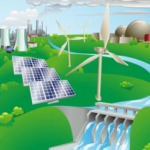|
Getting your Trinity Audio player ready...
|
 High energy consumption has become an essential part of our daily lives. The United States imports over 45 percent of its oil from outside countries. Just 25 percent comes from domestic production. There are growing concerns about future supply, and experts predict that by 2030 the country will be importing 90% of its oil.
High energy consumption has become an essential part of our daily lives. The United States imports over 45 percent of its oil from outside countries. Just 25 percent comes from domestic production. There are growing concerns about future supply, and experts predict that by 2030 the country will be importing 90% of its oil.
There are several technologies being developed to move away from fossil fuels. From hydrogen fuel cells to solar power, these new solutions are expected to replace much of today’s dependence on petroleum.
These seek to aim hotspots such as the real-money gambling town (Vegas) and the city of lights (New York), where energy consumption is particularly high.
Energy Consumption Statistics
Energy consumption per capita in the U.S. increased by 34% between 1950 and 1980 and fell slightly during the 1990s. It was estimated that by 2010 this figure would reach 35.1 million barrels per day (mbpd) which is less than half of what it peaked at in 1970. However, many believe that this decrease in consumption could be due to improved efficiency and reduced reliance on foreign oil as opposed to any actual improvement in consumer habits.
Removal of Fossil Fuels
Fossil fuels currently account for 86% of total energy use which makes them indispensable in our modern economy. By 2050, however, renewable sources like wind, water, and solar power are expected to account for 50% of all energy consumed and fossil fuels will be used only 30%.
If these numbers were accurate, it would mean a shift away from coal, oil, and gas by 2050. The Future of Energy in America has the potential to change everything we do.
The Age of Electric Cars
Electric cars have been popular for quite some time but they’ve never really gotten mainstream attention until recently. With sales increasing by more than 600%, they’re finally becoming accepted. This effectively cuts down fossil fuel consumption by up to 80%.
These electric vehicles have also proven themselves to save money for consumers as well as help reduce emissions. In fact, Americans have spent over $200 billion dollars in 2021 alone on electric car purchases.
Increasing Wind Energy Levels
Wind power already accounts for 15% of installed electrical capacity worldwide, but only 1% of electricity generated by all forms of power generation here in the US. Since 2000, electricity produced via wind power has grown by over 500%. As a result, there have been major improvements in wind turbine technology with blades reaching heights of 200 feet or higher and rotating at speeds of 5 rotations per minute.
Despite these advances, experts estimate that current wind turbines can produce 12 times more energy than their first generations.
Increasing Solar Energy Levels
Solar power has risen as a source of clean energy over the past decade. In 2009, solar power was approximately 2.5% of America’s total electricity output. Experts claim that the growth rate of solar power in the US is one of the fastest growing sources of renewable energy. They predict that by 2040 solar energy will generate 27% of the world’s total electricity demand.
Conclusion
I hope you enjoyed learning more about the future of energy in America. It certainly seems to be going through a period of drastic changes. However, I think most people would agree that there are many other issues facing us today that require immediate action. Instead, make your voice heard for what you believe in and how you can help make the world a better place.